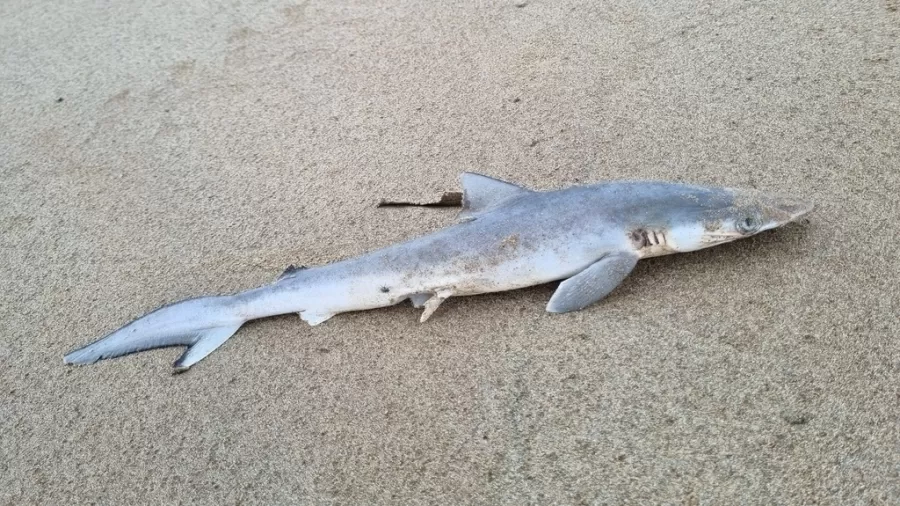Cocaine Found in Sharks: A Warning About Ocean Pollution
- Dakila News
- Aug 18, 2024
- 5 min read
Marine Pollution and Drug Trafficking: Investigating Contamination in Sharks
About 269 million people worldwide use drugs every year. A basic biological fact often forgotten is that what goes into the body must come out. Sewage is full of drugs excreted by the human body, with fragmented chemical components that have effects similar to the drugs themselves.
The results of a recent study surprised biologists investigating the effects of marine pollution on coastal wildlife. Focusing on Brazilian sharpnose sharks (Rhizoprionodon lalandii), also known as the black shark, the researchers analyzed 13 specimens captured between September 2021 and August 2023 in the waters of Recreio dos Bandeirantes beach in Rio de Janeiro.
These small sharks, measuring between 46 and 73 centimeters in length, were inadvertently caught by local fishermen. The study revealed something alarming: all the sharks analyzed had significant traces of cocaine and its metabolite, benzoylecgonine, in their muscle and liver tissues. Furthermore, all the females analyzed were pregnant, raising concerns about the potential effects of cocaine exposure on these animals' fetuses.
The discovery intrigued scientists, who observed levels of cocaine three times higher than those of benzoylecgonine, suggesting that the drug had not been metabolized before entering the marine environment. This is the first time that cocaine has been detected in sharks, with concentrations approximately one hundred times higher than those found in other marine animals studied.
These animals are considered good indicators of environmental quality and are often used in studies assessing the presence of ocean pollutants. Studies highlight several barriers that make it difficult for the drug to be incorporated into shark tissues. "For the drug to reach the animal, there needs to be a large volume circulating in the environment," said the scientist.
Sharks may absorb cocaine directly through their gills or by consuming smaller prey that contains the substance. This bioaccumulation through the food chain may explain why sharks had higher levels of cocaine than other aquatic organisms previously tested, the study authors said.
The negative effects of cocaine on sharks are considered "probable" by the study's authors, based on previous studies that have shown harm to zebrafish and mussels exposed to the drug. Research has shown that cocaine can affect the fish's vision and hunting ability, as well as impacting egg formation and steroid hormone production in eels, resulting in lower egg maturation rates.
Studies conducted in the Czech Republic and published in the Journal of Experimental Biology examined the exposure of brown trout to methamphetamine and found changes in the fish’s brain chemistry similar to those seen in human addiction. This addiction can lead to a loss of interest in essential activities such as feeding and reproduction, impacting the fish’s survival. Although there is evidence, the broader effects of these drugs on marine ecosystems are still largely unknown.
Although the amount of cocaine identified in the sharks is in the millionths of a gram, much smaller than that ingested by drug users, “We cannot say whether human health will be impacted, but the results serve as a warning about what we are throwing into the seas and what we are feeding on,” said Enrico Mendes Saggioro, leader of the group that found the drugs in the sharks.
Researcher Rachel Davis also claims that the drug can enter the human body through the common consumption of dogfish sharks as food in Brazil. Dogfish—the popular name under which the meat of several species of shark is sold—is popular in different regions of Brazil.
Saggioro’s study used a small sample size, which prevented the conclusions from being extrapolated to other animals. Since the scientists did not collect water samples from the capture site, the team understood the limitations of their results and decided to publish their unpublished results promptly. They are now conducting new studies to better understand these findings, testing other marine species, and analyzing water samples to draw a more comprehensive picture of cocaine and other contaminants in the entire Rio de Janeiro river basin.
The detection of cocaine in sharks, which has drawn public attention, is a sign that these and other fish are possibly contaminated by pollutants dumped into the sea every day. In addition to cocaine, other illicit drugs, medications, hormones, microplastics, heavy metals and various compounds have already been identified in marine organisms. "We are making the oceans sick," said Saggioro.
Despite all the fuss about the high quantity of cocaine and other pollutants in the waters, pollution through sewage discharge is not the only hypothesis for this case. Researchers are considering the possibility that the sharks have ingested fractions of cocaine packages destined for international trafficking.
The Special Maritime Police Unit (Nepom) of the Rio de Janeiro Federal Police supports this theory, highlighting that Recreio dos Bandeirantes is close to the port of Itaguaí, used to ship drugs to Europe.
In maritime trafficking, cocaine is often packaged in waterproof material and hidden in underwater compartments on ships. Therefore, the police believe that a shipment may have been released, contaminating the fish, which would explain the high amount of cocaine found in the sharks.
Other contamination in aquatic environments
An article published in Nature Sustainability also warns of a growing threat to biodiversity, ecosystem services, and public health due to the widespread contamination of marine ecosystems with active pharmaceutical ingredients. This type of pollution, involving legal and illegal pharmaceutical residues, has been little studied about wildlife in oceans, rivers, and lakes.
Scientists have previously detected traces of cocaine and other illegal drugs in marine animals near major cities like London and off the coast of Florida. In 2019, researchers in the UK found cocaine in freshwater shrimp in all 15 rivers they sampled, finding illicit drugs more frequently than some common pharmaceuticals.
Environmental pollution from these chemicals can occur in several ways, including improper handling during drug production and human consumption. When a person takes a drug, not all the compound is broken down by the body, and some of it ends up being excreted in the sewage system.
Large amounts of sewage often end up in rivers and coastal waters without proper treatment, and once in the environment, these drugs and their byproducts can harm wildlife. This alarming scenario highlights the urgent need for more research and action to mitigate the impacts of pharmaceutical pollution on aquatic ecosystems.
Article:
References:
Tubarões da costa do Brasil são encontrados com cocaína em seus corpos. Como isso aconteceu? | National Geographic (nationalgeographicbrasil.com)
Poluição: peixes estão ficando viciados em drogas — e efeitos preocupam cientistas | Biodiversidade | Um só Planeta (globo.com)













Comments